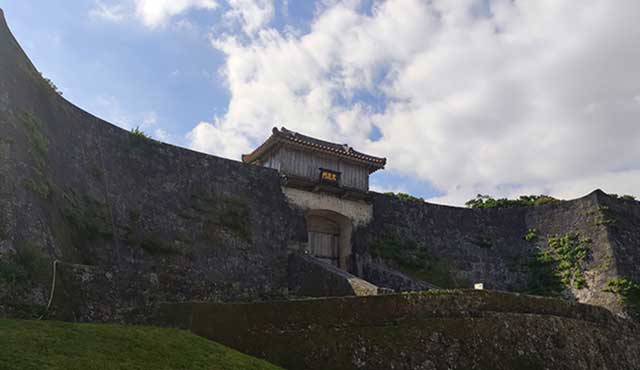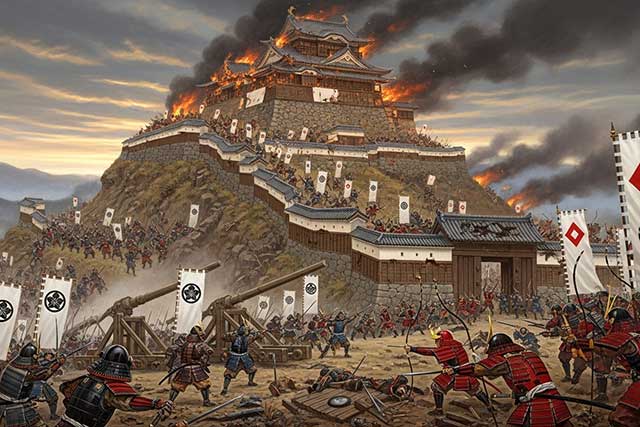
The Ryukyu Kingdom was established in 1429 on Okinawa, the largest island of the Ryukyu (Nansei) archipelago, as a result of the military unification of three rival kingdoms. In the following years, the state's control spread to all the islands of the archipelago.
Formally, Ryukyu was independent, but in reality it was a vassal state of the Chinese Empire. Relations with China were characterized by vassal dependence: the Ryukyuans received Chinese embassies, sent gifts, and recognized the supremacy of the Celestial Empire, while maintaining internal self-government.
The plans of the Shimazu clan
In 1606, the Shimazu clan from the Satsuma domain, located on the island of Kyushu and having long-standing ties with the Ryukyu Kingdom, appealed to the newly established Tokugawa shogunate for permission to annex the Ryukyu Islands to Japan. Permission was granted by the shogunate, and the Shimazu clan began preparations for a military expedition.
The Satsuma army was based on arquebusiers, who had proven their effectiveness during the Korean campaigns. In addition, the army included archers, spearmen, and cavalry, but the main focus was on gunfire.
Unlike Japanese warriors, ordinary Ryukyu infantrymen were armed with short swords similar to Japanese wakizashi and small wooden shields. The Ryukyuans also had firearms, but these were more primitive Chinese models.
One or three short barrels were attached to a long pole; such guns were loaded from the barrel end, and the shot was fired by lighting the fuse by hand. Ryukyu armor was a mixture of Chinese and Japanese elements.
Invasion of the islands
Shimazu's army of three thousand soldiers and five thousand support personnel (sailors and workers) under the command of General Kabayama Hisataka sailed from Kyushu on 100 ships on April 8, 1609.
Three days later, the Japanese landed on the Amami Islands, which they completely captured in nine days. Between April 24 and 28, the remaining islands on the way to the main island of the archipelago, Okinawa, were conquered.
On April 29, the samurai landed in northern Okinawa and attacked Nakijin Castle. The fortress was captured by May 1. After that, the invasion force headed south by sea and landed in Yomitan Harbor on May 3.
Here, the army split up: part of the troops headed overland to Urasoe Castle, while the rest sailed to Naha Port, which served as the maritime gateway to the kingdom's capital, Shuri.
The Japanese soon took Urasoe Castle and, in a short battle, captured the strategically important Taiheikyo Bridge. The way to the capital was open. The army approached Shuri around May 4.
The Battle of Shuri
At the same time, the Japanese fleet attempted to break through to the capital from the sea. The port of Naha was well fortified: at the entrance to the harbor stood two stone forts, between which the defenders stretched an iron chain. The forts were armed with several cannons.
The Japanese ships were unable to enter the port and withdrew north to Makiminato. This episode was the only military success of the Ryukyuans during the entire campaign. However, some historians believe that the naval attack was only a diversionary tactic, as the land army had already begun its assault on Shuri Castle at that time.
Shuri Castle was built in 1427 on the site of earlier fortifications and was similar in design to other gusuku in Okinawa. It was located on a 130-meter hill, had its own water source, and several courtyards that descended in terraces to the foot of the hill.
The courtyards were separated by massive limestone walls 6 to 15 meters high and up to 3 meters thick. The fortress covered an area of about 46,000 square meters.
A distinctive feature of the castle was the presence of a palace complex in the inner courtyard, which was the official residence of the Ryukyu kings. The outer wall had four fortified gates, and the inner courtyards had eight.
The walls and gates of Shuri
The first gate on the way to the castle was the Shureimon Gate, built in 1555 on the west side. Unlike other powerful tower-type gates, it was a painted gate in the Chinese style.
A long corridor along the west wall led to the Kankai Gate. Further on, steps led to two successive gates, the Zuiseimon and Rokokumon. Here, officials usually got out of their palanquins and walked on foot.

The next gate, Kofukumon, was designed as a passageway in a large administrative building. The Hoshimon gate, similar in architecture, led to the inner palace courtyard, or una.
The palace complex was located around the perimeter of the una, resembling a smaller version of the Forbidden City in Beijing. Among them was the three-story Seiden Hall, where the throne of the Ryukyu kings was located on the richly decorated second floor.
The fall of the capital
The Shureimon Gate, due to its decorative nature, was the weakest element of the castle's defense. The garrison built a wall of shields in front of them, from behind which soldiers fired at the enemy with bows and guns. However, such a barricade could not withstand the hail of bullets that Japanese arquebusiers rained down on the defenders.
The Ryukyuans could only hope for the strength of their walls. But even they did not save them. The low parapet only hid the defenders up to their waists, and the straight walls created ideal conditions for the Japanese tactics tested in the Korean wars: to knock the defenders off the walls with dense rifle fire, and then assault troops climbed up the ladders.
The Okinawan chronicles mention a “secret weapon” used by the defenders. In preparation for the defense, the Ryukyuans collected hundreds of venomous habu snakes (yellow-green kufia, Protobothrops flavoviridis), which live only on the Ryukyu Islands. These snakes reach 2.5 meters in length and are known for their aggressiveness.
During the assault, the defenders allegedly threw habu snakes at the attackers. However, Japanese sources do not confirm this fact, and even if it did happen, it is unlikely that it caused serious damage to the besiegers.
All the castle's fortifications had been taken by May 6. King Shō Nei was captured along with his family and advisors.
The end of Ryukyu's independence
After capturing Shuri, the invading army moved overland to the port of Naha and captured it with almost no resistance. The Kingdom of Ryukyu fell after a 26-day war.
King Shō Nei was sent as a hostage first to Kyushu and then to Edo for an audience with the shogun. He was forced to swear an oath of allegiance. As a result, he retained his title, but became a vassal of the Shimazu clan and ruled Ryukyu as governor of the “province of Ryukyu.”
Formally, the kingdom retained its independence until 1879, when the new Meiji government abolished Ryukyu and turned it into Okinawa Prefecture.
See also
-
The Siege of Hara Castle

The Shimabara Rebellion of 1637–1638, which culminated in the siege of Hara Castle, was the last major uprising of the Edo period and had serious political consequences.
-
Battle of Tennoji

The confrontation between Tokugawa Ieyasu and Toyotomi Hideyori during the “Osaka Winter Campaign” ended with the signing of a peace treaty. On January 22, 1615, the day after the treaty was signed, Ieyasu pretended to disband his army. In reality, this meant that the Shimazu forces withdrew to the nearest port. On the same day, almost the entire Tokugawa army began filling in the outer moat.
-
The Siege of Fushimi Castle

Fushimi can perhaps be considered one of the most “unfortunate” castles of the Sengoku Jidai period. The original castle was built by Toyotomi Hideyoshi in the southeast of Kyoto in 1594 as his residence in the imperial city.
-
The Siege of Otsu Castle

The siege of Otsu Castle was part of the Sekigahara campaign, during which the so-called Eastern Coalition, led by Tokugawa Ieyasu, fought against the Western Coalition, led by Ishida Mitsunari. Otsu Castle was built in 1586 by order of Toyotomi Hideyoshi near the capital Kyoto, on the site of the dismantled Sakamoto Castle. It belonged to the type of “water castles” — mizujō — as one side of it faced Japan's largest lake, Lake Biwa, and it was surrounded by a system of moats filled with lake water, which made the fortress resemble an island.
-
The Siege of Shiroishi Castle

The siege of Shiroishi Castle was part of the Sekigahara campaign and took place several months before the decisive battle of Sekigahara. The daimyo of Aizu Province, Uesugi Kagekatsu, posed a serious threat to Tokugawa Ieyasu's plans to defeat the Western Coalition, and Ieyasu decided to curb his actions with the help of his northern vassals. To this end, he ordered Date Masamune to invade the province of Aizu and capture Shiroishi Castle.
-
The Second Siege of Jinju Castle

During the two Korean campaigns of the 16th century, the Japanese repeatedly had to capture enemy fortresses and defend occupied or constructed fortifications from the combined Korean and Chinese forces. Among all the operations of that time, the second siege of Jinju Castle is considered the most interesting from the point of view of siege warfare.
-
The Siege of Takamatsu Castle

The siege of Takamatsu Castle in Bitchu Province is considered the first mizuzeme, or “water siege,” in Japanese history. Until then, such an original tactic had never been used.
-
The Third Siege of Takatenjin Castle

The history of the castle prior to the conflict between the Tokugawa and Takeda clans is rather unclear. According to one version, the castle was built in 1416, when Imagawa Sadayoshi (1325–1420) was governor of Suruga Province and half of Totomi Province. Allegedly, it was he who ordered Imagawa Norimasa (1364–1433) to build this fortification. However, no reliable evidence has been found to support this. Another version is considered more plausible, according to which the castle was built during the conquest of Totomi Province at the end of the 15th century by Imagawa Ujitsuna (1473–1526) and his general Ise Shinkuro (Hojo Soon). In this case, another of Ujitsuna's generals, Kusima Masashige (1492–1521), is considered responsible for the construction.

